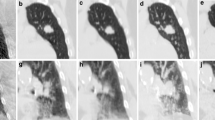Abstract
The performance of an image registration (IR) software was evaluated for automatically detecting known errors simulated through the movement of ExactCouch using an onboard imager. Twenty-seven set-up errors (11 translations, 10 rotations, 6 translation and rotation) were simulated by introducing offset up to ±15 mm in three principal axes and 0° to ±1° in yaw. For every simulated error, orthogonal kV radiograph and cone beam CT were acquired in half-fan (CBCT_HF) and full-fan (CBCT_FF) mode. The orthogonal radiographs and CBCTs were automatically co-registered to reference digitally reconstructed radiographs (DRRs) and planning CT using 2D–2D and 3D–3D matching software based on mutual information transformation. A total of 79 image sets (ten pairs of kV X-rays and 69 session of CBCT) were analyzed to determine the (a) reproducibility of IR outcome and (b) residual error, defined as the deviation between the known and IR software detected displacement in translation and rotation. The reproducibility of automatic IR of planning CT and repeat CBCTs taken with and without kilovoltage detector and kilovoltage X-ray source arm movement was excellent with mean SD of 0.1 mm in the translation and 0.0° in rotation. The average residual errors in translation and rotation were within ±0.5 mm and ±0.2°, ±0.9 mm and ±0.3°, and ±0.4 mm and ±0.2° for setup simulated only in translation, rotation, and both translation and rotation. The mean (SD) 3D vector was largest when only translational error was simulated and was 1.7 (1.1) mm for 2D–2D match of reference DRR with radiograph, 1.4 (0.6) and 1.3 (0.5) mm for 3D–3D match of reference CT and CBCT with full fan and half fan, respectively. In conclusion, the image-guided radiation therapy (IGRT) system is accurate within 1.8 mm and 0.4° and reproducible under control condition. Inherent error from any IGRT process should be taken into account while setting clinical IGRT protocol.




Similar content being viewed by others
References
Mackie TR, Kapatoes J, Ruchala K et al (2003) Image guidance for precise conformal radiotherapy. Int J Radiat Oncol Biol Phys 56:89–105
Jaffray DA, Siewerdsen JH, Wong JW et al (2002) Flat-panel cone beam computed tomography for image-guided radiation therapy. Int J Radiat Oncol Biol Phys 53:1337–1349
Engelsman M, Damen EMF, Jaeger KD et al (2001) The effect of breathing and set-up errors on the cumulative dose to a lung tumor. Radiother Oncol 60:95–105
Cho BCJ, Van HM, Mijnheer B et al (2002) The effect of set-up uncertainties, contour changes, and tissue inhomogeneities on target dose-volume histograms. Med Phys 29:2305–2318
Hong TS, Tome WA, Chappell RJ et al (2005) The impact of daily setup variations on head-and-neck intensity-modulated radiation therapy. Int J Radiat Oncol Biol Phys 61:779–788
Guckenberger M, Meyer J, Vordermark D et al (2006) Magnitude and clinical relevance of translational and rotational patient setup errors: a cone-beam CT study. Int J Radiat Oncol Biol Phys 65:934–942
Schwarz M, Van der Geer J, Van Herk M et al (2006) Impact of geometrical uncertainties on 3D CRT and IMRT dose distributions for lung cancer treatment. Int J Radiat Oncol Biol Phys 65:1260–1269
Dawson LA, Sharpe MB (2006) Image-guided radiotherapy: rational, benefits, and limitations. Lancet Oncol 7:848–858
Verellen D, Ridder MD, Storme G (2008) A (short) history of image-guided radiotherapy. Radiother Oncol 86:4–13
Grills I, Hugo G, Kestin L et al (2008) Image-guided radiotherapy via daily online cone-beam CT substantially reduces margin requirements for stereotactic lung radiotherapy. Int J Radiat Oncol Biol Phys 70:1045–1056
Chung HT, Xia P, Chan LW et al (2009) Does image-guided radiotherapy improve toxicity profile in whole pelvic-treated high-risk prostate cancer? Comparison between IG-IMRT and IMRT. Int J Radiat Oncol Biol Phys 73:53–60
Galerani AP, Grills I, Hugo G et al (2010) Dosimetric impact of online correction via cone-beam CT-based image guidance for stereotactic lung radiotherapy. Int J Radiat Oncol Biol Phys 78:1571–1578
Dawson LA, Jaffray DA (2007) Advances in image-guided radiation therapy. J Clin Oncol 25:938–946
AAPM Report no 104 (2009) The role of in-room kV X-ray imaging for patient setup and target localization. American Association of Physicists in Medicine, One Physics Ellipse, College Park, MD 20740-3846
Jaffray DA, Siewerdsen JH (2000) Cone-beam computed tomography with a flat-panel imager: initial performance characterization. Med Phys 27:1311–1323
Bissonnette JP, Moseley DJ, Jaffray David A (2005) A quality assurance program for image quality of cone-beam CT guidance in radiation therapy. Med Phys 35:1807–1815
Yoo S, Kim GY, Hammoud R et al (2006) A quality assurance program for the on-board imagers. Med Phys 33:4431–4447
Bissonnette JP, Moseley D, White E et al (2008) Quality assurance for the geometric accuracy of cone-beam CT guidance in radiation therapy. Int J Radiat Oncol Biol Phys 71:S57–S61
Verellen D, Soete G, Linthout N et al (2003) Quality assurance of a system for improved target localization and patient set-up that combines real-time infrared tracking and stereoscopic X-ray imaging. Radiother Oncol 67:129–141
Fox T, Huntzinger C, Johnstone P et al (2006) Performance evaluation of an automated image registration algorithm using an integrated kilovoltage imaging and guidance system. J Appl Clin Med Phys 7:97–104
Meyer J, Wilbert J, Baier K et al (2007) Positioning accuracy of cone-beam computed tomography in combination with a hexapod robot treatment table. Int J Radiat Oncol Biol Phys 67:1220–1228
Letourneau D, Martinez A, Lockman D et al (2005) Assessment of residual error for online cone-beam CT guided treatment of prostate cancer patients. Int J Radiat Oncol Biol Phys 62:1239–1246
Ploquin N, Rangel A, Dunscombe, P (2008) Phantom evaluation of a commercially available three modality image-guided radiation therapy system. Med Phys 35:5303–5311
Kessler ML (2006) Image registration and data fusion in radiation therapy. Br J Radiol. 79:S99–S108
Murphy M (1999) The importance of computed tomography slice thickness in radiographic patient positioning for radiosurgery. Med Phys 26:171–175
Author information
Authors and Affiliations
Corresponding author
Rights and permissions
About this article
Cite this article
Sharma, S.D., Dongre, P., Mhatre, V. et al. Evaluation of automated image registration algorithm for image-guided radiotherapy (IGRT). Australas Phys Eng Sci Med 35, 311–319 (2012). https://doi.org/10.1007/s13246-012-0158-9
Received:
Accepted:
Published:
Issue Date:
DOI: https://doi.org/10.1007/s13246-012-0158-9




